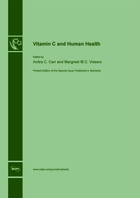Vitamin C and Human Health
A special issue of Nutrients (ISSN 2072-6643).
Deadline for manuscript submissions: closed (31 July 2013) | Viewed by 192955
Special Issue Editors
Interests: vitamin C; intake recommendations; respiratory infections; immune function; diabetes; metabolic health; mood; cognitive health; health-related quality of life
Special Issues, Collections and Topics in MDPI journals
Interests: vitamin C in cancer and inflammation; oxidative stress; antioxidants; human bioavailability studies
Special Issue Information
Manuscript Submission Information
Manuscripts should be submitted online at www.mdpi.com by registering and logging in to this website. Once you are registered, click here to go to the submission form. Manuscripts can be submitted until the deadline. All submissions that pass pre-check are peer-reviewed. Accepted papers will be published continuously in the journal (as soon as accepted) and will be listed together on the special issue website. Research articles, review articles as well as short communications are invited. For planned papers, a title and short abstract (about 100 words) can be sent to the Editorial Office for announcement on this website.
Submitted manuscripts should not have been published previously, nor be under consideration for publication elsewhere (except conference proceedings papers). All manuscripts are thoroughly refereed through a single-blind peer-review process. A guide for authors and other relevant information for submission of manuscripts is available on the Instructions for Authors page. Nutrients is an international peer-reviewed open access semimonthly journal published by MDPI.
Please visit the Instructions for Authors page before submitting a manuscript. The Article Processing Charge (APC) for publication in this open access journal is 2900 CHF (Swiss Francs). Submitted papers should be well formatted and use good English. Authors may use MDPI's English editing service prior to publication or during author revisions.
Keywords
- human status
- bioavailability
- vitamin C-dependent enzymes
- gene regulation
- cancer
- cardiovascular disease
- neurological effects
- inflammation








